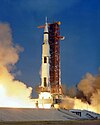Saturn-Shuttle
| Country of origin | United States |
|---|---|
| Size | |
| Height | 86 m (281 ft)[1] |
| Diameter | 10 m (33 ft)[1] |
| Mass | 2,300,000 kg (5,070,000 lb)[1] |
| Stages | 2 |
| Capacity | |
| Payload to LEO | |
| Mass | 60,500 kg (133,400 lb)[1] |
| Launch history | |
| Status | Canceled |
| Launch sites | |
The Saturn-Shuttle was a preliminary concept of launching the Space Shuttle orbiter using a modified version of the first stage of the Saturn V rocket.[1] It was studied and considered in 1971–1972.[2]
Description
An
The addition of wings (and some form of landing gear) on the S-IC stage would allow the booster to
The Shuttle would handle space station logistics, while the Saturn V would launch components.
This would have allowed the International Space Station, using a Skylab or Mir configuration with both U.S. and Russian docking ports, to have been lifted with just a handful of launches. The Saturn-Shuttle concept also would have eliminated the Space Shuttle Solid Rocket Boosters that ultimately precipitated the Space Shuttle Challenger accident in 1986.
See also
- Buran programme
- Boeing X-20 Dyna-Soar
- X-37
- Dream Chaser
- List of launch vehicle designs
References
- ^ a b c d e f g h i j k l m n o p q r s t u v w x y z aa ab "Saturn Shuttle". www.astronautix.com. Archived from the original on October 27, 2016. Retrieved 2019-06-24.
- ^ Lindroos, Marcus (June 15, 2001). "Phase B' Shuttle contractor studies 1971". Introduction to Future Launch Vehicle Plans [1963-2001] – via PMView.
Further reading
- "Phase B' Shuttle contractor studies 1971". Archived from the original on January 27, 2023. Retrieved May 26, 2023.
- "Phase B' Shuttle cost tradeoffs 1971". Archived from the original on January 17, 2023. Retrieved May 26, 2023.
External links
- "Shuttle". www.astronautix.com. Archived from the original on July 12, 2016.
- Saturn Shuttle with Flyback Booster, video rendering by Hazegrayart

